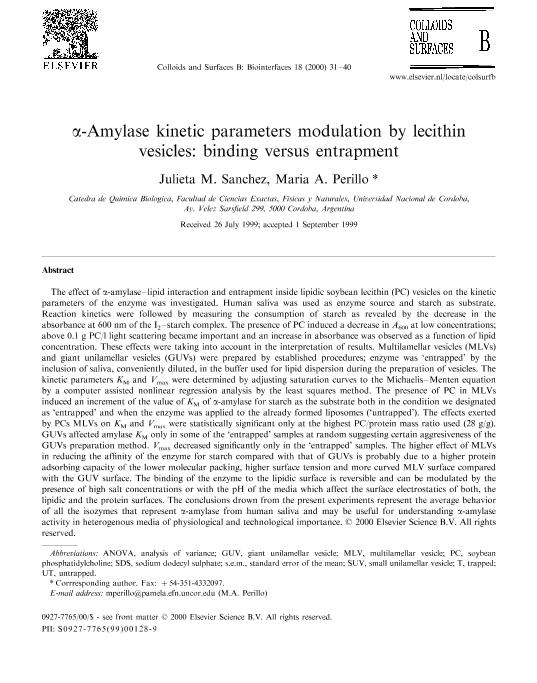Mostrar el registro sencillo del ítem
dc.contributor.author
Sanchez, Julieta Maria

dc.contributor.author
Perillo, Maria Angelica

dc.date.available
2018-11-15T14:54:53Z
dc.date.issued
2000-06-15
dc.identifier.citation
Sanchez, Julieta Maria; Perillo, Maria Angelica; α-Amylase kinetic parameters modulation by lecithin vesicles: Binding versus entrapment; Elsevier Science; Colloids and Surfaces B: Biointerfaces; 18; 1; 15-6-2000; 31-40
dc.identifier.issn
0927-7765
dc.identifier.uri
http://hdl.handle.net/11336/64527
dc.description.abstract
The effect of α-amylase-lipid interaction and entrapment inside lipidic soybean lecithin (PC) vesicles on the kinetic parameters of the enzyme was investigated. Human saliva was used as enzyme source and starch as substrate. Reaction kinetics were followed by measuring the consumption of starch as revealed by the decrease in the absorbance at 600 nm of the I2-starch complex. The presence of PC induced a decrease in A600 at low concentrations; above 0.1 g PC/l light scattering became important and an increase in absorbance was observed as a function of lipid concentration. These effects were taking into account in the interpretation of results. Multilamellar vesicles (MLVs) and giant unilamellar vesicles (GUVs) were prepared by established procedures; enzyme was 'entrapped' by the inclusion of saliva, conveniently diluted, in the buffer used for lipid dispersion during the preparation of vesicles. The kinetic parameters K(M) and V(max) were determined by adjusting saturation curves to the Michaelis-Menten equation by a computer assisted nonlinear regression analysis by the least squares method. The presence of PC in MLVs induced an increment of the value of K(M) of α-amylase for starch as the substrate both in the condition we designated as 'entrapped' and when the enzyme was applied to the already formed liposomes ('untrapped'). The effects exerted by PCs MLVs on K(M) and V(max) were statistically significant only at the highest PC/protein mass ratio used (28 g/g). GUVs affected amylase K(M) only in some of the 'entrapped' samples at random suggesting certain aggresiveness of the GUVs preparation method. V(max) decreased significantly only in the 'entrapped' samples. The higher effect of MLVs in reducing the affinity of the enzyme for starch compared with that of GUVs is probably due to a higher protein adsorbing capacity of the lower molecular packing, higher surface tension and more curved MLV surface compared with the GUV surface. The binding of the enzyme to the lipidic surface is reversible and can be modulated by the presence of high salt concentrations or with the pH of the media which affect the surface electrostatics of both, the lipidic and the protein surfaces. The conclusions drown from the present experiments represent the average behavior of all the isozymes that represent α-amylase from human saliva and may be useful for understanding α-amylase activity in heterogenous media of physiological and technological importance. Copyright (C) 2000 Elsevier Science B.V.
dc.format
application/pdf
dc.language.iso
eng
dc.publisher
Elsevier Science

dc.rights
info:eu-repo/semantics/openAccess
dc.rights.uri
https://creativecommons.org/licenses/by-nc-sa/2.5/ar/
dc.subject
Α-Amylase
dc.subject
Binding
dc.subject
Entrapment
dc.subject
K(M)
dc.subject
Kinetics Modulation
dc.subject
Soybean Phosphatidylcholine
dc.subject
V(Max)
dc.subject.classification
Otras Ciencias Biológicas

dc.subject.classification
Ciencias Biológicas

dc.subject.classification
CIENCIAS NATURALES Y EXACTAS

dc.title
α-Amylase kinetic parameters modulation by lecithin vesicles: Binding versus entrapment
dc.type
info:eu-repo/semantics/article
dc.type
info:ar-repo/semantics/artículo
dc.type
info:eu-repo/semantics/publishedVersion
dc.date.updated
2018-11-12T13:46:44Z
dc.journal.volume
18
dc.journal.number
1
dc.journal.pagination
31-40
dc.journal.pais
Países Bajos

dc.journal.ciudad
Amsterdam
dc.description.fil
Fil: Sanchez, Julieta Maria. Consejo Nacional de Investigaciones Científicas y Técnicas. Centro Científico Tecnológico Conicet - Córdoba; Argentina. Universidad Nacional de Córdoba. Facultad de Ciencias Exactas, Físicas y Naturales. Departamento de Química. Cátedra de Química Biológica; Argentina
dc.description.fil
Fil: Perillo, Maria Angelica. Consejo Nacional de Investigaciones Científicas y Técnicas. Centro Científico Tecnológico Conicet - Córdoba; Argentina. Universidad Nacional de Córdoba. Facultad de Ciencias Exactas, Físicas y Naturales. Departamento de Química. Cátedra de Química Biológica; Argentina
dc.journal.title
Colloids and Surfaces B: Biointerfaces

dc.relation.alternativeid
info:eu-repo/semantics/altIdentifier/url/https://www.sciencedirect.com/science/article/pii/S0927776599001289
dc.relation.alternativeid
info:eu-repo/semantics/altIdentifier/doi/https://dx.doi.org/10.1016/S0927-7765(99)00128-9
Archivos asociados
